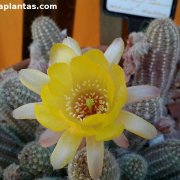Care of the cactus Echinopsis chamaecereus or Peanut Cactus |
|
The genus Echinopsis, family Cactaceae, comprises 150 species of cactus native to South America. Some species are: Echinopsis chamaecereus, Echinopsis candicans, Echinopsis bruchii, Echinopsis aurea, Echinopsis atacamensis, Echinopsis ancistrophora, Echinopsis oxygona, Echinopsis chiloensis, Echinopsis subdenudata, Echinopsis schickendantzii, Echinopsis mamillosa, Echinopsis tarijensis, Echinopsis schieliana, Echinopsis spachiana, Echinopsis pachanoi, Echinopsis rhodotricha, Echinopsis huascha, Echinopsis peruviana. Common name: Peanut Cactus. This species is native to Salta and Tucuman, Argentina. They are small cacti up to 15 cm (5.9") high, which form compact groups up to 50 cm (19.68") wide. The stems are light green in color and have 8-10 ribs. The spines (10 to 15) are white bristles 2 mm (0.07") long. The attractive orange-red flowers are 5 cm (1.96") in diameter. They bloom in late spring and early summer. Young specimens can bloom. Peanut Cactus is used in rockeries, in pots and to cover low maintenance areas of the garden. Echinopsis chamaecereus needs semi-shaded exposure in hot climates and full sun in colder regions. To bloom it needs good lighting. Do not expose it to temperatures below 2 ºC (35.6 ºF). Peanut Cactus can grow in poor, dry soils; they prefer a sandy soil with a little manure. Water in spring and summer waiting for the substrate surface to dry completely. If the winter temperature is below 5 ºC (41 ºF) there is no need to water. These cacti prefer a medium humidity. Fertilize in early spring with slow-release mineral cactus fertilizer. Echinopsis chamaecereus does not need pruning. If the humidity is too low, Peanut Cactus can be attacked by mites. Echinopsis chamaecereus propagates easily by cuttings in spring or summer. |
Images of the cactus Echinopsis chamaecereus or Peanut Cactus |
Find plants
Echinopsis chamaecereus or Peanut Cactus | Care and Growing
© 2025 FavThemes



